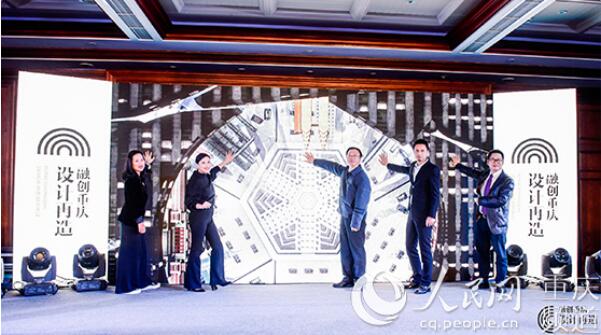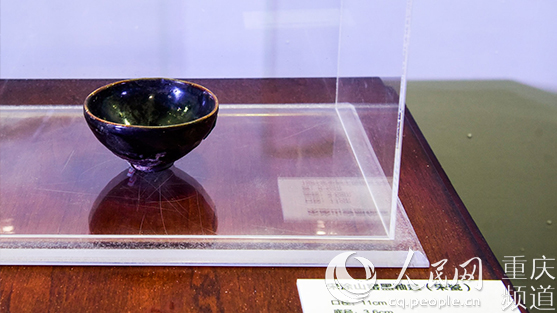


The inauguration of Sunac Chongqing design (Photo/People's Daily Online)
A forum focusing on the heritage of Chongqing's traditional craftsmanship took place at Sunac Baixiang Street, Chongqing city, on Nov. 17. The event stood as the first of its kind in Chongqing, jointly held by Sunac Chongqing, See the World and See the Creation. This forum attracted many domestic artists, such as the former goodwill ambassador of UNDP Zhu Zheqin, famous portrait photographer Xiao Quan and designer Yang Fang. This forum aimed to delve into the origin of the endangered traditional artistry of Chongqing. "We hope this forum can be the bridge between folk masters and modern design teams," said a person in charge of the event.
The Tujia Xilankapu attracts onlookers
As soon as somebody mentions Zhu Zheqin, her popular songs instantly spring to mind, such as "The Sister's Drum" and "A Truth Story." However, few people know that as the goodwill ambassador of UNDP, Zhu has devoted almost 10 years to the protection and development of her national culture.
Over the past nine years, Zhu and her team, working with some famous domestic and overseas designers, spent time in Inner Mongolia, Yunnan, Guizhou, and Tibet to explore and collect national decorative handicrafts. While doing so, they also developed these traditional handicrafts into modern artworks, to protect them from extinction.
As an ancient national folk craft, Xilankapu was listed in the first batch of national intangible cultural heritages in 2006.
Zhu said, "Xilankapu is a blanket with various decorative patterns, but the production process is complicated. The people of Tujia create dyes using plants, and use these natural dyes to paint colorful flowers, feathers, sunsets and rainbows."

Xilankapu on show (Photo/People's Daily Online)
According to statistics, Xilankapu originally had 120 pattern types, increasing to 200 over time as people developed their own styles. Unfortunately, only 80 patterns can be made today.
The director of Qianjiang Cultural Commission, Zhou Zhiyong, explained that Xilankapu has a historical and cultural foundation, and continues the area's traditional legacy. Relevant departments now need to focus on how to make it a brand and sell the patterns as a commodity. Zhu said, "We plan to establish a cultural team first, who will design and develop it according to its deep and long history, including making innovative products, holding exhibitions, and even making movies."
How to revive the lost Tushan kiln
"How can we make a craft permanent? The answer is to use it continuously."
In this forum, the Tushan kiln, which dates back to the Northern Song Dynasty, was a hot topic among guests.
According to research, the Na'an Tushan kiln is located in the valley between the mountains of Nanshan and Tushan, where many kilns have been found. The Tushan kiln is just one kind of folk kiln used in the Song Dynasty, and it is also the representative folk kiln in ancient south-west China. "The Southern Song Dynasty was the golden age for the Tushan kiln. According to historical texts, at the very beginning, many outstanding artisans came to Nanshan Mountain of Chongqing, and the porcelain made using the Tushan kiln became representative of the Song Dynasty.

Porcelain made using the Tushan kiln on show (Photo/People's Daily Online)
A person in charge of the event said, "Unfortunately, because of the emergence of white porcelain and the blue and white porcelain that is still famous today, the Tushan kiln, which had existed for 200 years, gradually disappeared during the Yuan Dynasty, and its craftsmen were also lost."
Now, the winner of the Red Dot Award, designer Michael Yang, will discuss the Tushan kiln with Chongqing specialists and research how to re-create it. "The team will learn from historical materials and ancient kiln instructions, to understand the details of this artistry. Then, the team will make new porcelain based on these foundations, to create dynamic porcelain which meets modern aesthetics."
 Fire brigade in Shanghai holds group wedding
Fire brigade in Shanghai holds group wedding Tourists enjoy ice sculptures in Datan Town, north China
Tourists enjoy ice sculptures in Datan Town, north China Sunset scenery of Dayan Pagoda in Xi'an
Sunset scenery of Dayan Pagoda in Xi'an Tourists have fun at scenic spot in Nanlong Town, NW China
Tourists have fun at scenic spot in Nanlong Town, NW China Harbin attracts tourists by making best use of ice in winter
Harbin attracts tourists by making best use of ice in winter In pics: FIS Alpine Ski Women's World Cup Slalom
In pics: FIS Alpine Ski Women's World Cup Slalom Black-necked cranes rest at reservoir in Lhunzhub County, Lhasa
Black-necked cranes rest at reservoir in Lhunzhub County, Lhasa China's FAST telescope will be available to foreign scientists in April
China's FAST telescope will be available to foreign scientists in April "She power" plays indispensable role in poverty alleviation
"She power" plays indispensable role in poverty alleviation Top 10 world news events of People's Daily in 2020
Top 10 world news events of People's Daily in 2020 Top 10 China news events of People's Daily in 2020
Top 10 China news events of People's Daily in 2020 Top 10 media buzzwords of 2020
Top 10 media buzzwords of 2020 Year-ender:10 major tourism stories of 2020
Year-ender:10 major tourism stories of 2020 No interference in Venezuelan issues
No interference in Venezuelan issues
 Biz prepares for trade spat
Biz prepares for trade spat
 Broadcasting Continent
Broadcasting Continent Australia wins Chinese CEOs as US loses
Australia wins Chinese CEOs as US loses